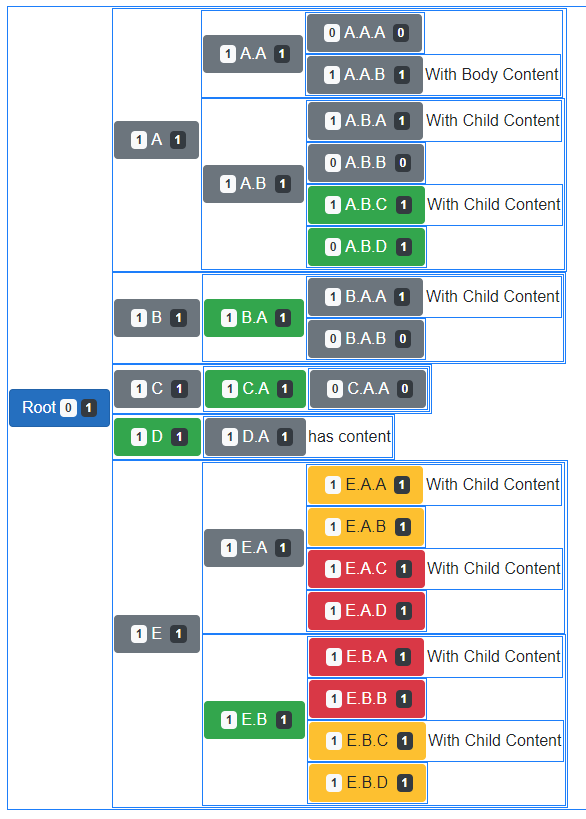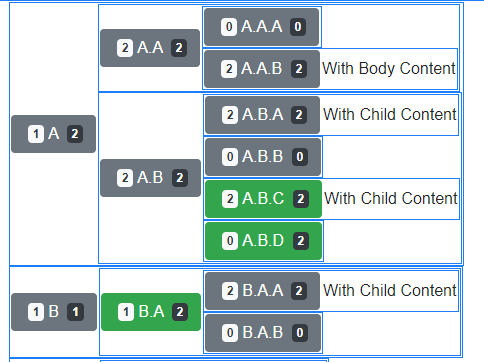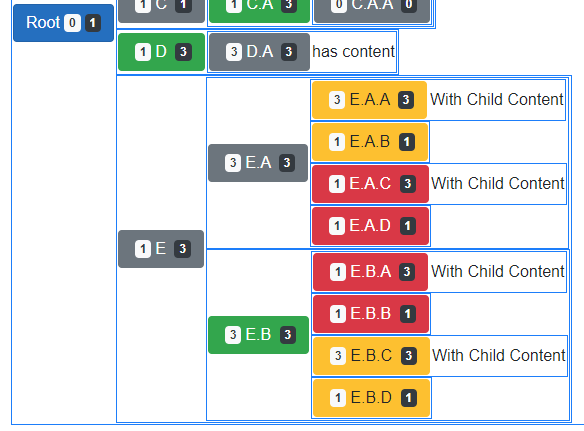This article explores the Blazor Component update process with code that demonstrates what is, and isn't happening.
Introduction
This article started life as some code I wrote to explore what I thought I already understood - the mechanics of Blazor Component Rendering.
Repo and Site
The code is available in the AllinOne Project on GitHub. The original project demonstrates how to combine Server and WASM under the same roof. You'll find the code in the Shared Project under AllinOne.Shared > Components > Controls, and the counter page AllinOne.Shared > Components > Views > Counter.razor.
The application is hosted on Azure at https://allinoneserver.azurewebsites.net/.
The Code
We're going to build a set of counter components that we can cascade in the Counter page.
Counter
First, we need a basic Counter class we can run as a service. Note the event for when Counter is incremented.
public class CounterService
{
public int Counter { get; private set; } = 0;
public event EventHandler CounterChanged;
public void IncrementCounter()
{
this.Counter++;
this.CounterChanged?.Invoke(this, EventArgs.Empty);
}
}
Add it to StartUp (Server) or Program (WASM).
public class Startup
{
......
public void ConfigureServices(IServiceCollection services)
{
.....
services.AddSingleton<CounterService>();
}
.....
}
public class Program
{
public static async Task Main(string[] args)
{
....
builder.Services.AddSingleton<CounterService>();
....
}
}
BaseCounter
BaseCounter implements the basic counter component functionality.

A button with two badges and a label between them. The left badge displays the value in the local counter variable, the right badge the CounterService.Counter value. OnParametersSetAsync sets the local counter to CounterService.Counter. Counter is therefore only updated when SetParametersAsync is called on the component by the Render.
@namespace AllinOne.Shared.Components
<table class="border border-primary">
<tr>
<td class="text-nowrap">
<button type="button" class="btn @this.buttoncolor"
@onclick="() => this.Service.IncrementCounter()">
<span class="badge bg-light text-dark mx-1">@this.counter</span>
@this.Name <span class="badge bg-dark text-white ml-1">
@this.Service.Counter</span>
</button>
</td>
@if (ChildContent != null)
{
<td width="90%">
@ChildContent
</td>
}
@if (Body != null)
{
<td width="90%">
@Body
</td>
}
</tr>
</table>
@code {
[Inject] public CounterService Service { get; set; }
[Parameter] public RenderFragment ChildContent { get; set; }
[Parameter] public RenderFragment Body { get; set; }
[Parameter] public string Name { get; set; } = "Add";
protected virtual string buttonclass => (ChildContent != null ||
Body != null) ? "col-2" : "col";
protected virtual string buttoncolor => "btn-secondary";
protected virtual int counter { get; set; }
protected override Task OnParametersSetAsync()
{
counter = Service.Counter;
return Task.CompletedTask;
}
}
EventCounter
EventCounter inherits from BaseCounter. It adds registration of a local ReRender event handler with the service CounterChanged event. ReRender forces a UI Update through StateHasChanged whenever the counter is updated.
@inherits BaseCounter
@code {
protected override string buttoncolor => "btn-success";
protected override Task OnInitializedAsync()
{
Service.CounterChanged += ReRender;
return base.OnInitializedAsync();
}
protected void ReRender(object sender, EventArgs e) =>
this.InvokeAsync(this.StateHasChanged);
}
CascadedValueCounter
CascadedValueCounter inherits from BaseCounter. It adds functionality to capture a cascaded CascadedCounter and sets the local counter to the captured value.
@inherits BaseCounter
@code {
[CascadingParameter(Name ="CascadedCounter")] public int cascadedcounter { get; set; }
protected override string buttoncolor => "btn-danger";
protected override Task OnParametersSetAsync()
{
counter = cascadedcounter;
return Task.CompletedTask;
}
}
CascadedObjectCounter
CascadedObjectCounter inherits from BaseCounter. It adds functionality to capture a cascaded CascadedService and sets the local counter to the captured CounterService.Counter.
@inherits BaseCounter
@code {
protected override string buttoncolor => "btn-warning";
[CascadingParameter(Name = "CascadedService")]
public CounterService CascadedService { get; set; }
protected override Task OnParametersSetAsync()
{
counter = CascadedService?.Counter ?? 0;
return Task.CompletedTask;
}
}
Counter Page
The final bit is to build a new counter page with various different combinations of counter components in component trees. Note the root counter, the injected CounterService and cascading values. We've also labelled each component to make referencing easier.
<h1>Counter</h1>
<table class="border border-primary">
<tr>
<td class="text-nowrap">
<button type="button" class="btn btn-primary"
@onclick="() => this.Service.IncrementCounter()">
Root <span class="badge bg-light text-dark">@this.counter</span>
<span class="badge bg-dark text-white ml-1">@this.Service.Counter</span>
</button>
</td>
<td width="90%">
<CascadingValue Name="CascadedService" Value="this.Service">
<CascadingValue Name="CascadedCounter" Value="this.Service.Counter">
<BaseCounter Name="A">
<BaseCounter Name="A.A">
<BaseCounter Name="A.A.A"></BaseCounter>
<BaseCounter Name="A.A.B"><Body>With Body Content</Body>
</BaseCounter>
</BaseCounter>
<BaseCounter Name="A.B">
<BaseCounter Name="A.B.A">With Child Content</BaseCounter>
<BaseCounter Name="A.B.B"></BaseCounter>
<EventCounter Name="A.B.C">With Child Content</EventCounter>
<EventCounter Name="A.B.D"></EventCounter>
</BaseCounter>
</BaseCounter>
<BaseCounter Name="B">
<EventCounter Name="B.A">
<BaseCounter Name="B.A.A">With Child Content</BaseCounter>
<BaseCounter Name="B.A.B"></BaseCounter>
</EventCounter>
</BaseCounter>
<BaseCounter Name="C">
<EventCounter Name="C.A">
<BaseCounter Name="C.A.A"></BaseCounter>
</EventCounter>
</BaseCounter>
<EventCounter Name="D">
<BaseCounter Name="D.A">has content</BaseCounter>
</EventCounter>
<BaseCounter Name="E">
<BaseCounter Name="E.A">
<CascadedObjectCounter Name="E.A.A">With Child Content
</CascadedObjectCounter>
<CascadedObjectCounter Name="E.A.B"></CascadedObjectCounter>
<CascadedValueCounter Name="E.A.C">With Child Content
</CascadedValueCounter>
<CascadedValueCounter Name="E.A.D"></CascadedValueCounter>
</BaseCounter>
<EventCounter Name="E.B">
<CascadedValueCounter Name="E.B.A">With Child Content
</CascadedValueCounter>
<CascadedValueCounter Name="E.B.B"></CascadedValueCounter>
<CascadedObjectCounter Name="E.B.C">With Child Content
</CascadedObjectCounter>
<CascadedObjectCounter Name="E.B.D"></CascadedObjectCounter>
</EventCounter>
</BaseCounter>
</CascadingValue>
</CascadingValue>
</td>
</tr>
</table>
@code {
[Inject] public CounterService Service { get; set; }
protected virtual int counter { get; set; }
protected override Task OnParametersSetAsync()
{
counter = Service.Counter;
return Task.CompletedTask;
}
}
What's Going On?
Go to allinoneserver.azurewebsites.net to see the page in action.
The left value is the value of the local counter variable. If it's not the current value, then SetParametersAsync wasn't called on the component at the last event (normally a button click).
The right value displays the current CounterService.Counter. If it's up to date, then the component was re-rendered through StateHasChanged at the last event. If not, then it wasn't.
- Blue is the Root Counter (a
BaseCounter) - Grey are
BaseCounters - Green are
EventCounters - Amber are
CascadedObjectCounters - Red are
CascadedValueCounters - With Child Content are counters with content in
ChildContent - With Body Content are counters with content in
Body
Let's look at some scenarios:
Click Root
Most of the children update. The event has caused a cascaded SetParametersAsync on child components. For example, A.A has the both values set to the current value, so SetParametersAsync has been called. Note SetParametersAsync calls StateHasChanged automatically.
However, A.A.A didn't update. Unlike A.A.B it has no child content. You can see this elsewhere - B.A.B and C.A.A for example.

Click A
We now see just some are updated. A has updated, but only the second value. The button click initiated a call to StateHasChanged automatically causing a component render, but SetParametersAsync wasn't called. The child components have reacted in the same way as a root click - only components with child content have updated.
The green counters have all updated - for example A.B.C and A.B.D - regardless of whether they have child content or not. Direct dependents of A with child content have had SetParametersAsync run, those without child content, or not descendants haven't. They have rendered through their event handlers wired into the CounterService.CounterChanged event. Note also that any children of EventCounters - B.B.A for example - with child content have also updated.

Click E
Notice that the yellow and red Cascaded Counters with content have updated, but not the ones without content. Also note that on yellow CascadedObject Counters both values are current, while on the red CascadedValue Counters the left side values haven't updated. SetParametersAsync has run, but the cascaded value hasn't been updated. It's a primitive so only set when the page loads or Root is clicked. The object cascade is a pointer to the object which is updated to date.

New Browser Window
Open a new browser Window on the same page. Put the two side by side. Click anywhere on one.
What happens depends on whether you're running in Server or WASM mode. In Server mode, all the green counters (and children with content) get updated in the other window. In WASM, nothing happens. In Server mode, CounterService is running as a singleton, with all copies of the application using the same object, and thus wired to the same event. In WASM mode, there's no such thing as a Singleton - they run as scoped.
Conclusion
I could sit here and try to define a set of coding rules to cover the various scenarios. But.., why attempt jumping through hoops when the kitchen sink approach - service events - just works.
My recommendation is simple, use service events.
History
- 18th December, 2020: Initial version
